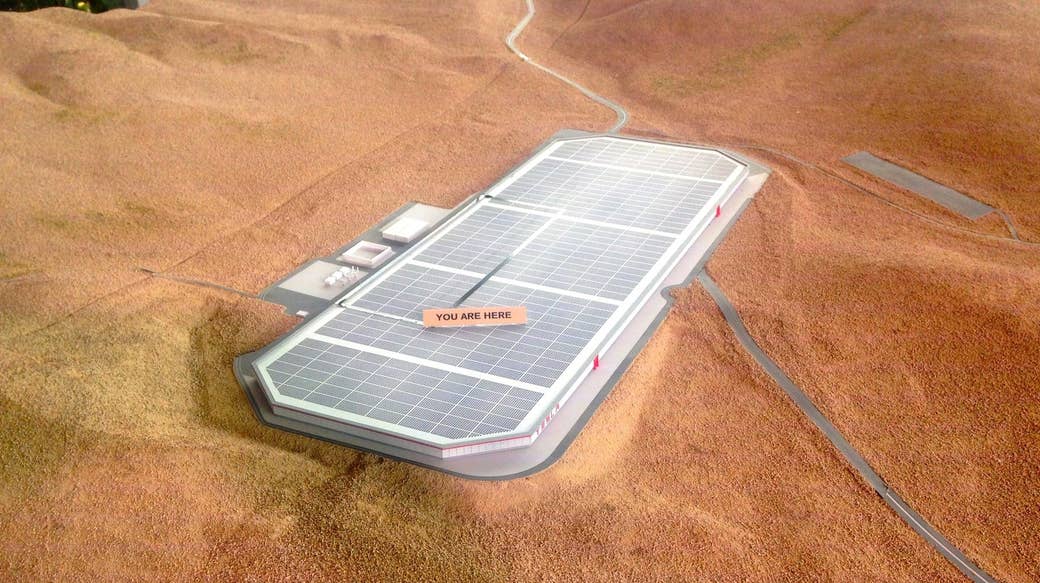
Drive about 25 miles east from Reno, Nevada, along vacant, sweaty desert highway, and soon enough you’ll see it, white edges rising from red dust like a giant domino plunked down on Mars.
Just over 14 percent completed, Tesla’s new battery factory already operates on a scale so big that the company had to make up a new word for it: “Gigafactory,” because apparently “factory” wasn’t quite grandiose enough.
When construction is over, this will be the largest building in the world by footprint — large enough, as Tesla’s CEO Elon Musk is fond of saying, to fit 93 747s, one Vatican City, or 50 billion hamsters, whichever image you find most evocative. (I like the hamsters.) By 2018, it will, according to Tesla, produce more lithium-ion battery cells than were produced by every factory on the face of the planet in 2013.
It will also be a proving ground for one of the already audacious company’s biggest moonshots, manufacturing the batteries that will power the Model 3. This is Tesla’s first foray into mass-market cars, and the vehicle that will — or won’t — bring electric vehicles to the mainstream. Last year, Tesla produced 50,000 cars. In 2018, it aims to produce 500,000. That’s a lot of batteries, and it’s a lot of ambition for a company that has a long history of missing its deadlines, and that is currently under federal investigation after an Ohio man fatally drove into a tractor trailer while using his Model S’s “autopilot” mode.
But on Friday night, the factory was mostly just a really surreal venue for a really big party. About 2,000 Tesla superfans had been summoned here to the high desert to celebrate the Gigafactory’s opening — why wait until 2018? — and boy, had they heeded the call. By 4:30 p.m. or so, more than an hour before the event was to start, the line of Teslas and charter buses waiting to drive onto the grounds stretched more than mile down a road aptly called “Electric Avenue.” The Teslas had been driven in by their owners from all over North America, the charter buses from a downtown Reno climbing gym-slash-boutique hotel, where the company had reserved a block of rooms for party guests. (That afternoon, its lobby boasted a massive, slowly melting ice sculpture in the shape of Tesla’s signature lethal-looking “T.” Lots of people took selfies in front of it.) Bus riders took video and chattered about the cars surrounding them, pointing out rare paint jobs and models. The line was so long that a little boy in a tiny sport coat had to hop out of his father’s Model X and take a leak on the highway’s tree-bare shoulder.
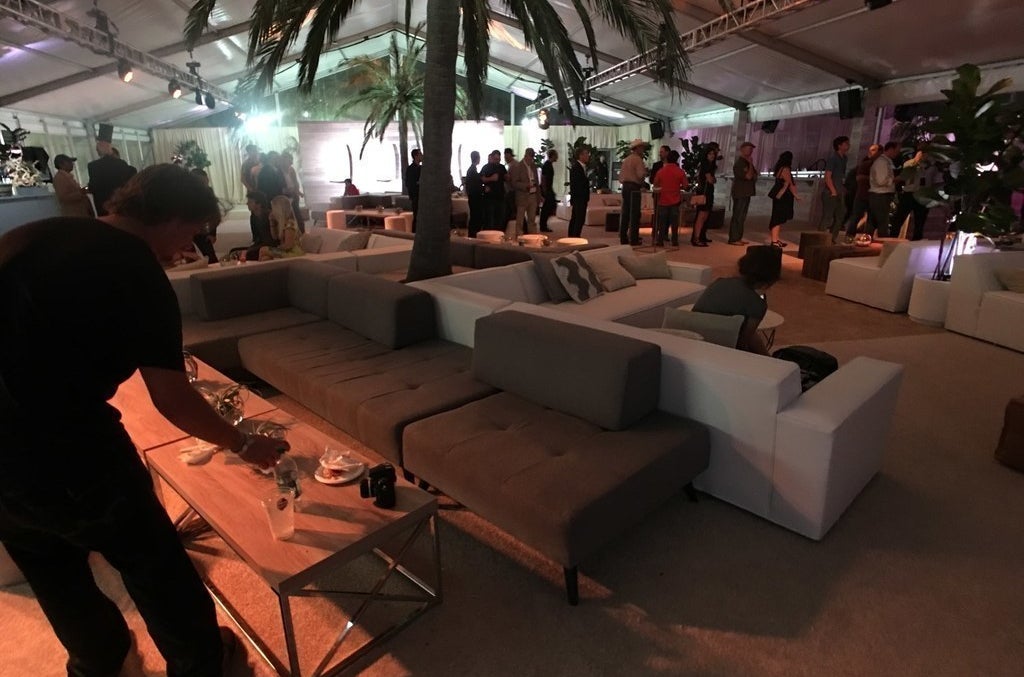
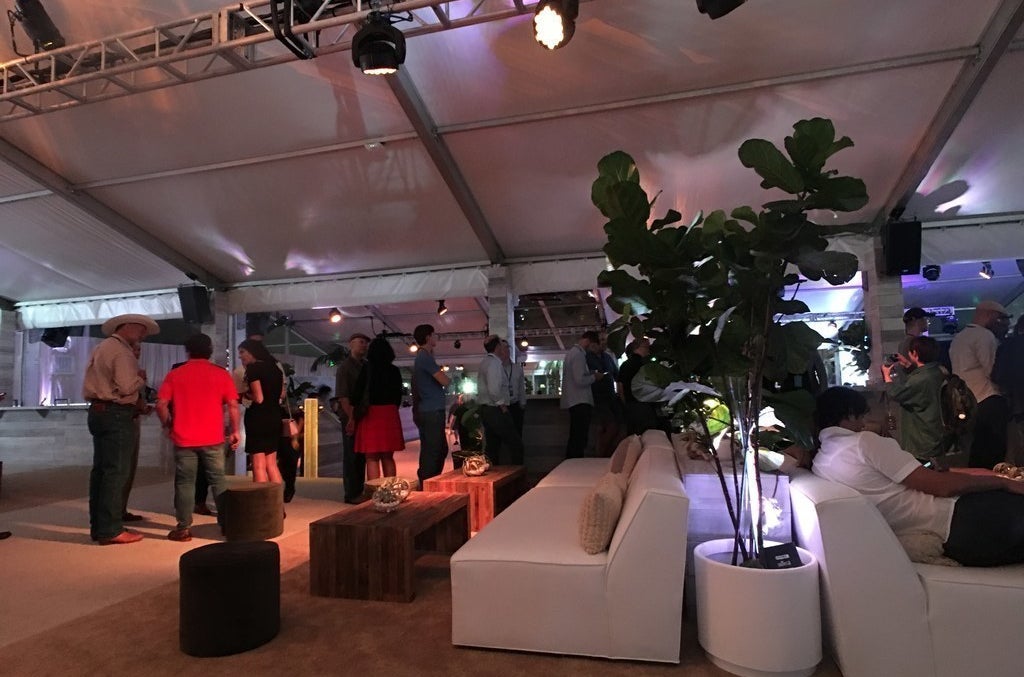
Walk across a dusty pavement runway, stand in a roped-off line, get a badge, follow the thudding bass 'til you turn a corner, and you’ll enter a white tent about twice the size of a basketball court. It had been erected just for the occasion, at a reported price of $300,000. The company had trucked in the full Fancy Party starter pack: plush, sand-colored carpet, purple and blue lights, low-slung, immaculate white leather couches, tabletop terrariums, full-size palm trees. Waiters circled with ham and grilled cheese sandwiches, mozzarella and tomato salad, and those little wooden-spoon thingies filled with tuna crudo.
They wore T-shirts with slogans like "Don’t Mess With Tesla” and “Occupy Mars” and “Watch Elon Go!"
Tesla PR’s department repeatedly invoked Burning Man in its press pitch, but save from the setting and possibly the money, the vibe was more Dad’s Night Out than techno-futurist bacchanal. Average age: 50s. Prevailing demeanor: Unchecked earnestness. Unofficial dress code: Polo tucked into jeans. Most popular snack: Salami. Line chatter revolved around specs and components and what exactly do you think is going into the cathodes? About 300 yards away, the factory remained running all evening — about 1,000 humans and untold robots staff are staffing it for the time being, and they seemed more-or-less unbothered by the packs of people walking through on guided tours, taking photos.
Near the entrance, attendees posed gleefully in front of Powerwalls — poster-sized, wall-mounted battery packs — the way Disney World visitors might in front of Cinderella's Castle. At the tent’s far edge, they examined a scale architectural model of the finished factory with scientific fastidiousness, taking notes and shooting video. They wore T-shirts with slogans like “Don’t Mess With Tesla” and “Occupy Mars” and “Watch Elon Go!" and “Tesla: It’s Not Just a Passion, It’s My Obsession.” They lined up eagerly for tours of a partially built battery factory and test rides of a car many of them already owned. They beamed.
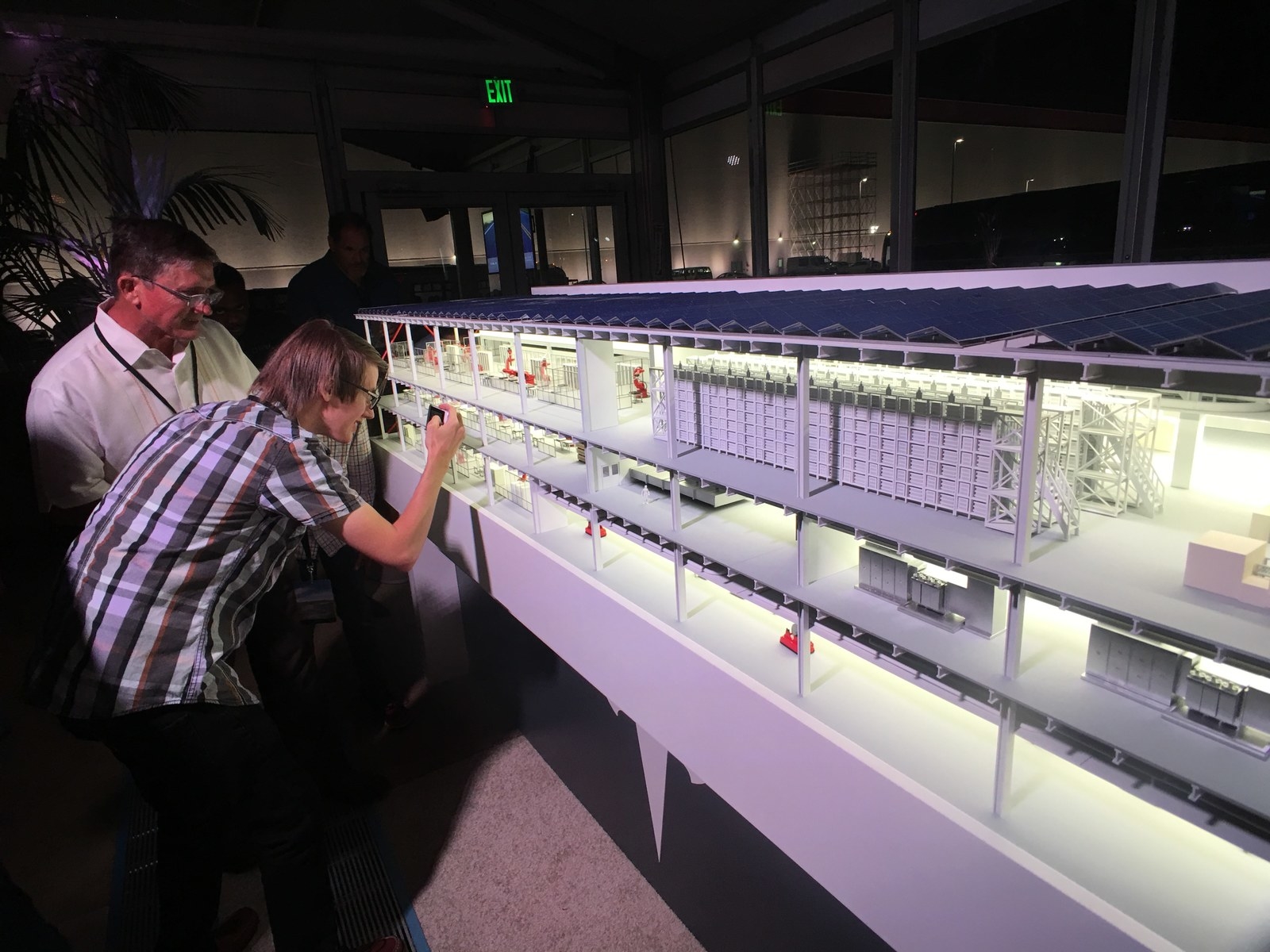
They had come from Virginia Beach and Chicago and Denmark and Switzerland and, of course, San Francisco, to be here. One guy drove out over four days from Orlando with a fellow Floridian Tesla enthusiast that he’d met in a forum; in the drinks line, over the deep-house remix of “Gimme Shelter” thumping through hidden speakers, he eagerly pulled out his phone to show me a picture of his new vanity plate, which read “Tedsla X.” (His name, he explained helpfully, is Ted.) A handful of customers had flown in from Australia and wore matching "TESLA SYDNEY" T-shirts. They communicated via WhatsApp — and then, once the group grew too large for that platform, Slack — explained a 36-year-old engineer from Canberra. He had flown 30 delay-beset hours to the sweltering middle of nowhere for the weekend, leaving his partner at the hotel for the evening because he had just one ticket. But his only complaint was about the car he drove in from the airport: “I rented a Porsche. It’s way slummier than my Tesla.”
Aside from entrepreneur and noted Tesla fan Jason Calacanis, nearly everyone there — or at least those I talked to — had fairly normal upper-middle-class, white-collar jobs: Lawyer, doctor, web designer. They weren’t exactly what one Midwestern attendee described as “The Tesla stereotype: Rich, 1-percenter. California. Greedy douche bag.” By means of comparison, the 2016 Tesla Model S starts at less than $60,000 with federal incentives. The Mercedes-Benz S-Class, another high-tech luxury sedan, starts around $96,000. As Calacanis himself has correctly pointed out, it’s “not exactly a Maybach.” (Those, for the record, start as low as $185,000 or so but can go up to $1,350,000. As much as Teslas have become a symbol of outsize urban wealth, it’s hard to imagine Kanye West driving one around in a music video.)
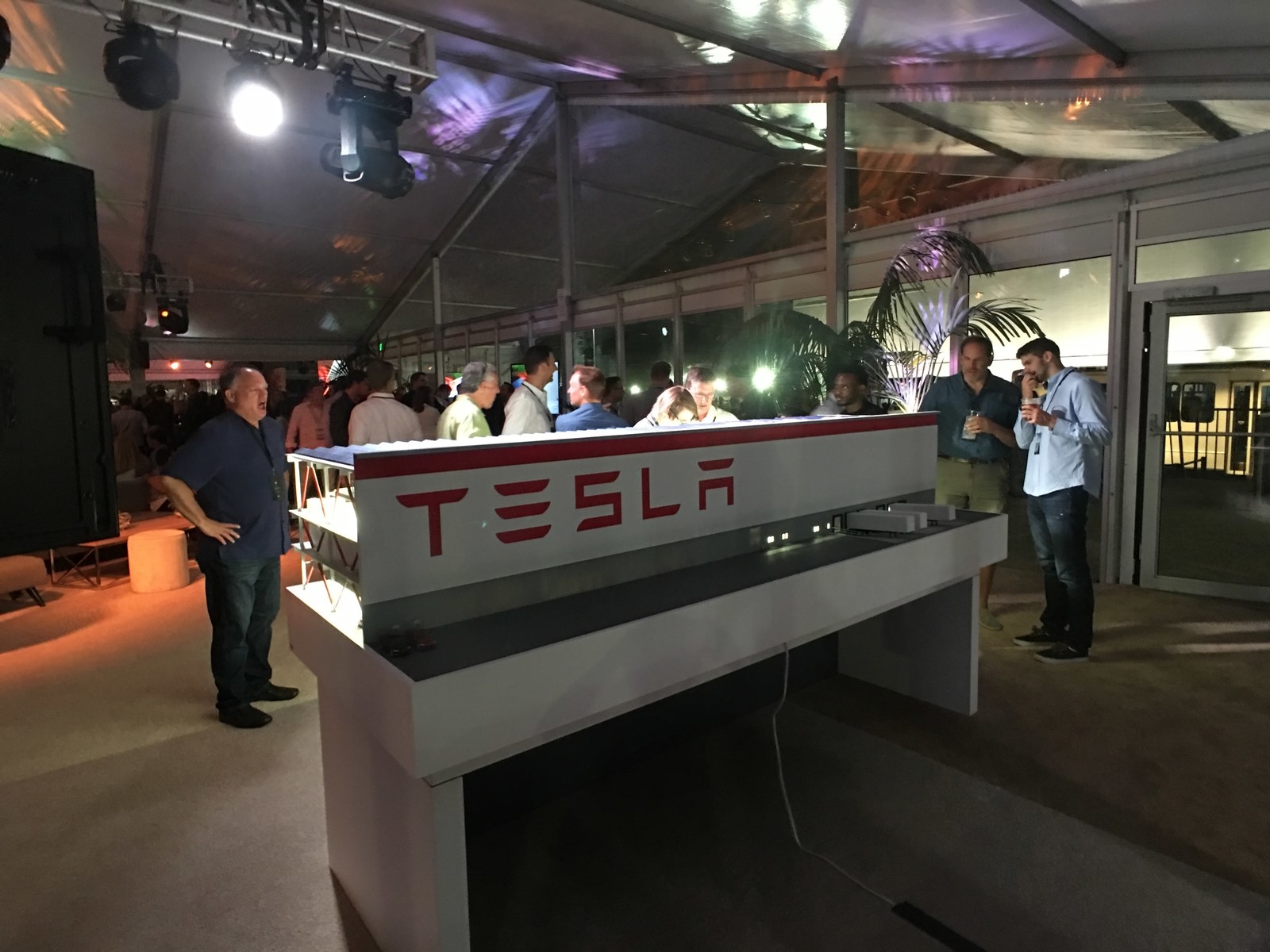
Many got the invitation because they’d referred five other people to put down deposits on the cars. Others had entered a lottery open to people who already owned Teslas. Still others came as the lucky plus-one to someone who’d won the lottery or made the five referrals. In many of those cases, they’d only ever met their host on forums.
A Chicago-based graphic designer in Tommy Bahama-plaid shirtsleeves had won the lottery. “When you get an invitation like this,” he said, “you go.”
I guess you do. For the uninitiated, however, it’s hard to understand what, exactly, is drop-everything appealing about a high-summer invitation to eat finger salami in the 100-degree heat. One skeptical plus-one compared it to his teenage daughter’s One Direction fandom, but the more popular — and apt — comparison seemed to be early-stage Apple fandom: a community, an identity, a consumer choice made by people who hope it conveys something elemental about themselves.
“It’s like the first time you saw an iPhone,” said Kevin, a self-described “gadget guy,” “Elon nerd,” and father of two from Chicago.
Chris Alessi II, a single father living in Madison, Wisconsin, offered an analogy. “A gas car is like a Nokia flip phone. A Tesla is like an iPhone 6S. It’s a completely different experience.”
Alessi, who wore a fedora and goatee, was affable and talkative. He bought his first Tesla — number 9846, he said, proudly — in 2013, after “getting rid of the ex-wife.” Shortly thereafter, he began filming videos about his car and putting them on YouTube.
“Some guys go out and get their Harley when they have a midlife crisis,” he said. “I got a Tesla.”
“Some guys go out and get their Harley when they have a midlife crisis. I got a Tesla.”
Three years later, his channel has more than 14,600 subscribers, and he supports his family on its ad revenue, plus a small amount of side work in scooter repair, videography, live video streaming, and chauffeur services, according to his business card, which he hands out readily and which includes an Uber promo code on the back. Over the course of a 20-minute conversation, fans repeatedly interrupted him to say hello, asking after his sons and posing for selfies with him. “I’ve shaken so many hands tonight I probably shouldn’t even be touching my food,” he said, gesturing to a plate full of ham and cheese.
“The Tesla is safe, economical, functional,” he said. “Pure bliss to drive. It’s just purely superior in every way, shape, or form.”
Pure bliss. For all of this company’s high-minded environmentalist ambition — for its multiple master plans and Musk’s discussion of ending global reliance on fossil fuels — the prevailing sense under the tent was Teslas are superior simply because they are really fucking fun to drive. If this is environmentalism, it’s a messy kind of environmentalism, one that has less in common with granola than it does with, say, Soylent. “I can tell you that there’s more Republicans driving Teslas than there are Democrats,” Alessi told me. “I don’t drive them because I want to save the planet. I drive them because they’re a superior vehicle.” The appeal is not exactly that Teslas are better for the environment, it’s that the future happens to be in electric vehicles, and these people want to be first to the future, whatever it looks like. Environmentalism isn’t the end, it’s the means. Have some more salami.
“For a long time, [electric vehicles] have been associated with, like, Ralph Nader,” Kevin, the Chicagoan, said. “But the Tesla isn’t a compromise car. It’s fast as hell, can go far, quiet, safe. This feels like a vision of the future.”
“In a good way,” he hastened to add.
Around 9 p.m., Musk took the stage, bathed in light, for a short speech. He went over statistics about the factory’s size and answered a few questions, a chorus of whoops and hollers filling up every pause.
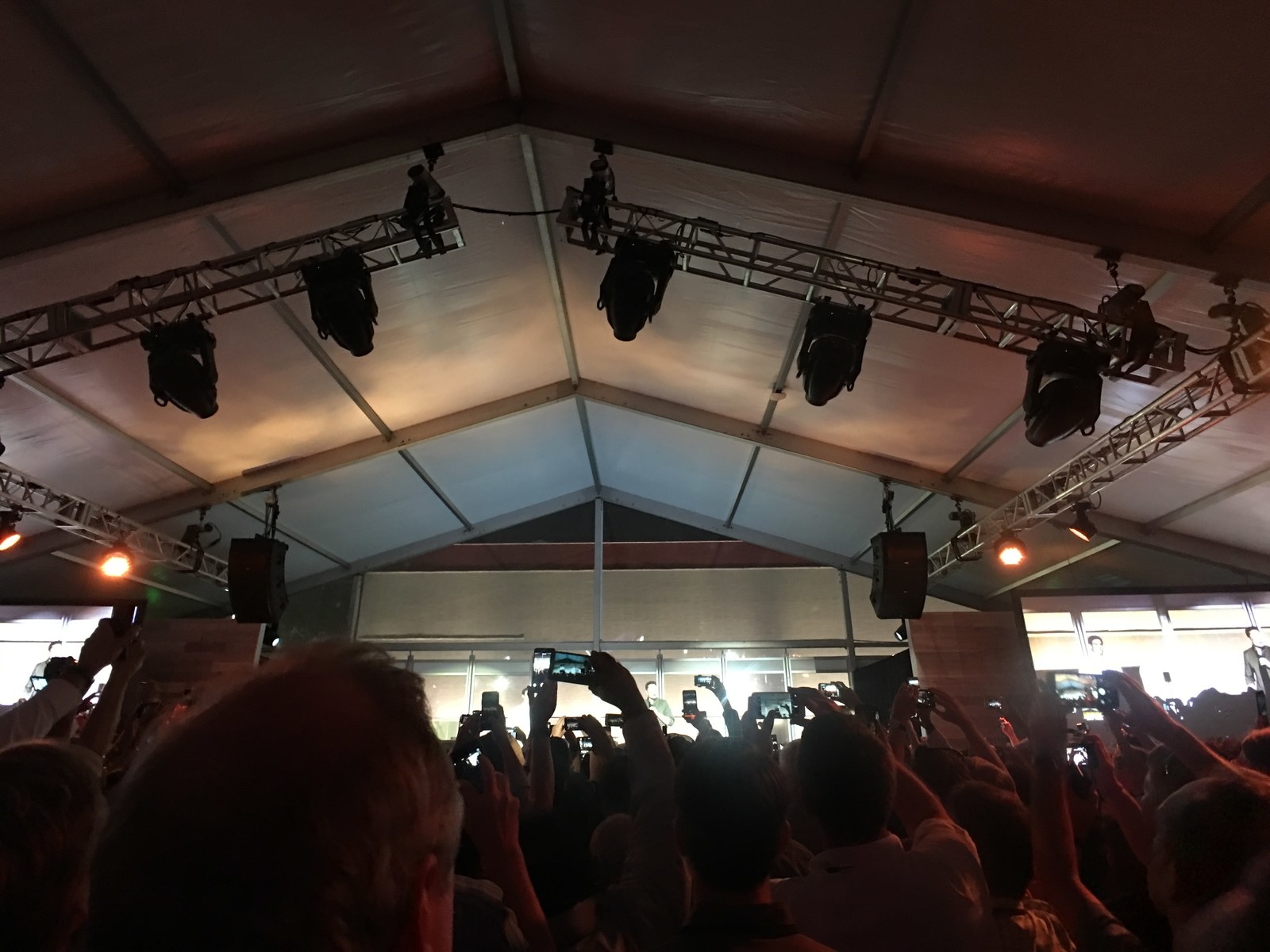
“The Tesla mission is to accelerate the world through sustainable energy,” he said. “It matters to the world. It matters if it happens sooner or later. It matters if it happens at scale.”
“It’s about making enough electric cars, enough stationary battery packs that it actually moves the needle from a global carbon-production perspective — that it actually does really change the world,” Musk continued, with all the audacity of an ice sculpture in the desert. “It has to be big because the world is big.”
“Beam me up, Elon!” someone shouted from the front.
Musk smiled. Here he was in a temple bigger than the Vatican, surrounded by people who believe in his vision so much they came here to see it 14-percent built. You’d be smiling, too, but of course it helps when your handlers remind you to.
By 11 p.m. or so, not a soul was on the dance floor for a funk cover of “Get Your Freak On,” but the line for factory tours still snaked 40 or 50 long through the ballroom. A guy wearing a matching blazer, pants, and T-shirt in Tesla’s blood-red chatted up a Chinese car vlogger toting a massive video rig. By midnight, an hour before the party was set to end, the room was nearly empty and the bar staff had begun packing up. No one was here for the free drinks, anyway.
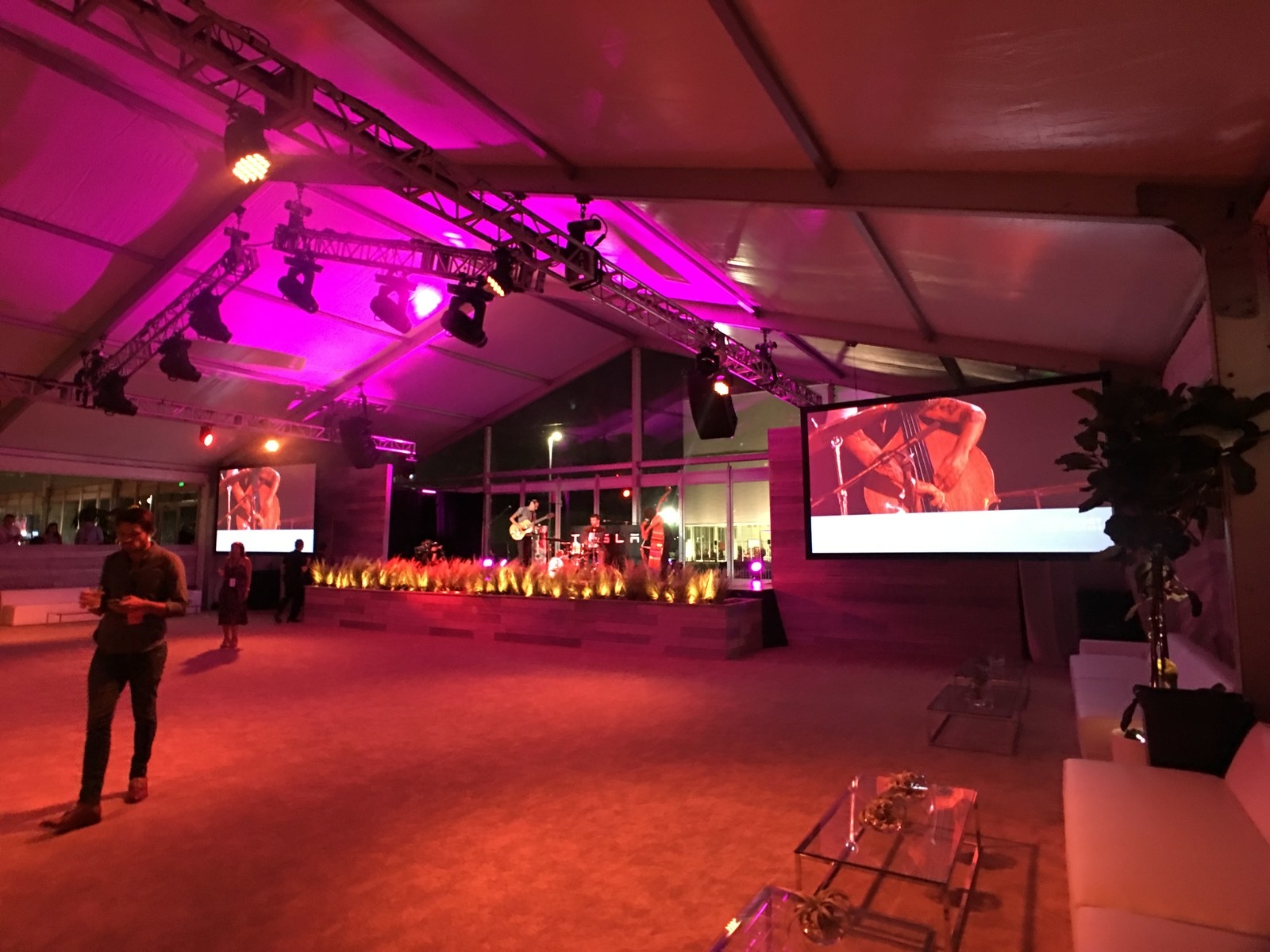
CORRECTION
A Tesla model S costs around $66,000, or less than $60,000 after federal incentives. An earlier version of this article misstated the price.
